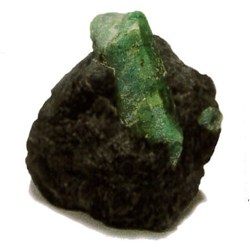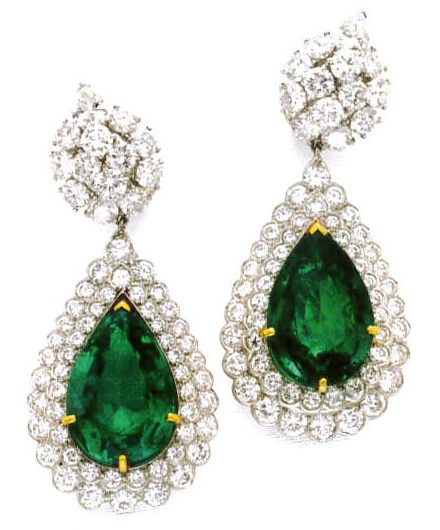Coloured Stone Guide – Emeralds
Belonging to the beryl family

Rough Emerald
Perfecting its imperfections
Emerald is probably the one gemstone that stands out above all others as being accepted despite its imperfections. Totally clean emeralds are few and far between, and the vast majority show a range of inclusions, which have come to be known as the ‘jardin’ of the stone, from the French for ‘garden’ because they can resemble foliage. These are natural features found in the rough crystals, and which can make the stone difficult to cut. and prone to breakage in certain directions. Due to this, a specific style of cut was developed, that offered protection to the stone, and allowed it to take its place amongst the ‘big 4′ gemstones. We have come to know this style as the ’emerald-cut’, a term which nowadays can be applied to any stone cut in a retangular form, with the corners truncated, but which was originally used to prevent these corners chipping or breaking during setting. On the plus side though, this range of inclusions and internal features can be used by trained gemmologists and laboratories to help narrow down the original locality from which the emerald came. Certain features, such as an enclosed cavity within the stone, that contains a liquid, a solid crystal, and a gas bubble, can be indicative of a Colombian emerald, while other features can point to other localities, such as Zimbabwe and Zambia.
Identification, care and maintenance
How to identify an emerald – well, in 1934 Gem-A, working with Chelsea Polytechnic, developed a filter that would differentiate an emerald from its many simulants of the day, and this was named the Chelsea Colour Filter·. Today, with advances in methods of synthesis and lab growth, the filter isn’t possibly as useful as it used to be, but it is still a very valid gemmological tool. Other results of gemmological tests show that emerald has a hardness of 7.5, and a refractive index of 1.57 to l.60, and also a spectrum that can be seen with a handheld spectroscope. Care should be taken not only when testing emeralds, but also when cleaning and repairing any jewellery set with them. Almost all emeralds are routinely oiled, a fact that is well known to most. The oil helps disguise any surface reaching fractures, making them less visible. This isn’t anything new, or anything to worry about, it’s been ongoing for centuries, but it’s not advisable to put an emerald into an ultrasonic or steam cleaner. or expose it to heat during repair, as the oil can be drawn out.
Emerald’s place in myth and folklore
Legend has it that emerald could cure some diseases, and even had the power to reveal the future, if placed under the tongue (not to be recommended!). It’s also thought that it can calm
and soothe sore/tired eyes, simply by looking at it. Other sources have it as being able to strengthen the memory, and even protect from giddiness, which could be useful in both respects for late nights down the pub! From the desirability side, though, it serves as the birthstone for May (possibly representing the new growth of spring), and is the gemstone associated with both the 20th and 35th wedding anniversaries. And finally … did you know that the cause of the green colour in emerald is chromium – the same element that causes red in ruby! Isn’t nature wonderful!

Diamond earrings with pear-shaped Colombian emerald, by Van Cleef & Arpels
